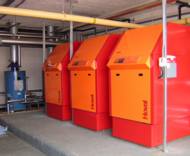Out with the old . . .

Existing oil-fired boilers will already have space for fuel storage, so replacement with biomass boilers is an option. Hoval BioLyt wood-pellet boilers are available with outputs from 10 to 70 kW. They switch off and reignite automatically and can achieve an efficiency of up to 95%. To maintain efficiency, heating surfaces are self cleaning.
Refurbishing or upgrading existing heating plant provides the opportunity to deliver very significant increases in efficiency but there are a number of factors that need to be taken into account. Kevin Stones takes a look at the key considerations.Replacing an old boiler is no longer just a matter of getting the same model and plumbing it in — the Building Regulations now demand that a more efficient boiler is installed, which will have implications not just for the boiler but also for the other parts of the system connected to it. At the same time, building operators are looking for ‘greener’ solutions, which increasingly will be in the form of condensing boilers — and/or biomass boilers in some instances. If a non-condensing boiler is replaced with a condensing boiler, the chances are that the existing heat emitters will be sized to provide flow and return temperatures of around 82ºC and 71ºC, respectively — a return temperature that is too high for condensing operation. However, this does not mean that a condensing boiler should not be used, because condensing boilers still give greater seasonal efficiencies than atmospheric boilers, even when they are not condensing. In addition, there are ways of maximising condensing operation, such as making the most of the cooler return temperatures when the system starts up in the morning. Also, if the system combines different kind of emitters — say underfloor heating and radiators — it may be possible to split the return flows into high- and low-temperature branches on the associated boiler. Another benefit of using condensing boilers is the better turndown they offer, — so that the boiler and burner will run with fewer starts and stops, and NOx emissions will be reduced accordingly, which helps with the BREEAM rating. NOx emissions from condensing boilers are generally around half those from the best atmospheric boilers. When a pressure-jet oil boiler is being replaced it may be possible to add a condensing economiser to introduce condensing operation; solutions such as this will become increasingly viable as low-sulphur fuel oils become available. Of course, if a pressure jet boiler is being replaced with a gas condensing boiler there will be additional benefits in terms of reduced emissions, noise and electrical consumption.
Biomass On the other hand, an existing oil boiler will have provision for fuel storage and access for delivery vehicles, making wood pellet biomass boilers a strong contender as the replacement plant. When gas-fired plant is being replaced or supplemented with wood-pellet boilers, the storage and delivery aspects will need to be taken into account. As a rule of thumb, 1 kg of wood pellets will provide 4.9 kWh of heating, and a cubic metre of storage space will accommodate 600 to 650 kg of wood pellets. In all cases, it is just as important to consider the control of the boiler as the choice of boiler itself. If the existing controls are quite old they may not interface easily with the new plant — or additional sensors may be required to provide the additional information required by modern controllers. If biomass and fossil-fuel boilers are being mixed — perhaps with other renewables such as solar heating the controls will be particularly important to get the sequencing correct. New boilers may require higher gas and minimum water pressures than older boilers, so that pressurisation kit for either service is required.
 |
The large turndown offered by condensing boilers enables them to run with fewer starts and stops, reducing NOx emissions. Hoval’s Ultragas condensing boilers have a turndown of 6:1 on boilers up to 250 kW and 12:1 on larger models. |
Pressure can also be a challenge in taller buildings where access to the plant room is difficult. For example, the building may need 10 to 12 bar of working pressure but it may not be feasible to get replacement equipment to match, especially where access is restricted. In such cases, it may be more practical to assemble a 6 bar cast-iron sectional boiler in situ and use a plate heat exchanger to separate the two systems. In fact, access and footprint will often be the deciding factor in retrofit projects. Flues also need to be checked for suitability, especially when condensing boilers are introduced to the system. The same is true for valves, and if they need replacing in situations where hot-water services need to be maintained the project requires very careful planning. This can also be an ideal time to install extra valves and increase zoning to make maintenance easier and less disruptive. It is also a good time to consider replacing sacrificial anodes in calorifiers with permanent anodes if that is appropriate.
Maintenance Installing new plant will almost certainly impact on the maintenance regime, and the system should certainly be cleaned out before new boilers are installed. Ongoing maintenance should also be planned to address the performance and legislative needs of the new system, rather than the old, and we would strongly recommend using maintenance operatives that have an in-depth understanding of the plant. The important point about all of this is that changing or even refurbishing a boiler will inevitably affect the way it interacts with other parts of the system, so it is vital to think it through with attention to every detail.
Kevin Stones is technical director with Hoval.
Related links:









